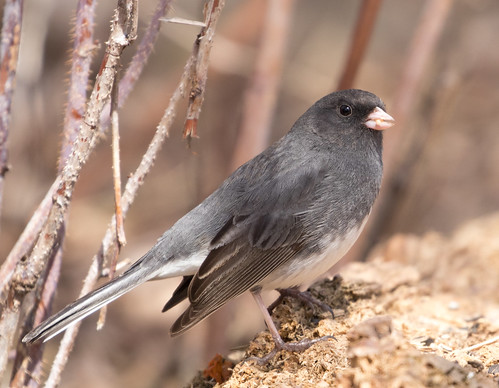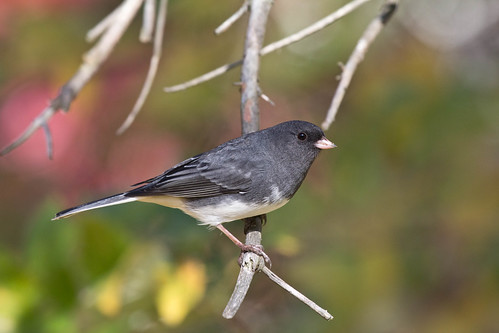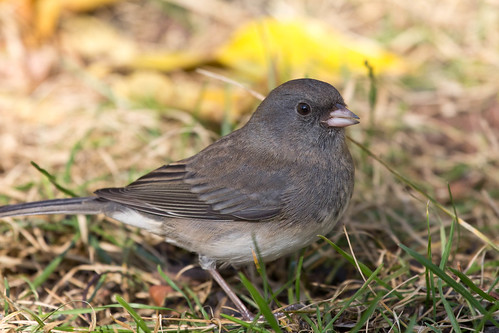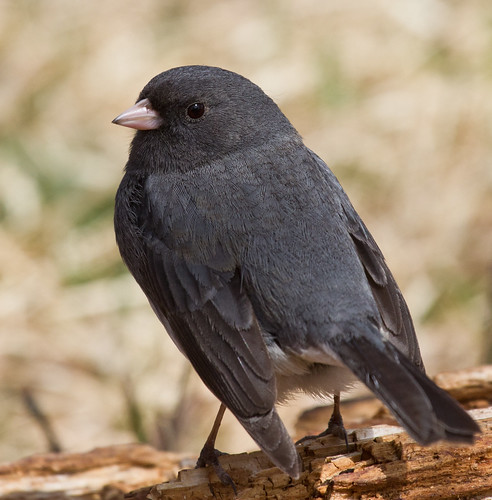Monday, April 6, 2020
Junco Migration Kicks In!
This winter was the worst for birds in my yard since we moved to Duluth in 1981, and it was even more disappointing for me because of my heart attack on January 3—I couldn't help but wish that I could see birds while stuck at home much of the time. Things didn’t pick up much until last Thursday, April 2, when voila! A dozen juncos materialized out of nowhere.
I saw my very first junco on March 21, 1975, in Russ’s parents’ backyard in Chicago when I was a brand-new birder. Something about their beautiful slate-gray plumage with the perfect white tummy and those white tail streamers, so wonderfully distinctive as they fly away, filled my heart with gladness.
Russ’s mom was shocked that I’d never seen them before—they were of course quite common in spring and fall, so you’d think I’d have at least once noticed one flying off and wondered what it could be, but most of us are blind to most of the things in our everyday lives that we aren’t intentionally conscious of. It’s really the only way we can cope—to notice everything is to be like a baby at a shopping mall, looking every which way with amazement, unable to make sense of any of it because there is simply too much. To survive, by the time we’re toddlers we filter out most of the sensations hitting our eyes and ears, and by the time we’re adults, we filter out all but the very most pertinent sights and sounds.
Juncos had to have crossed my field of view many times when I was young, but never once crossed my awareness until that March day. But as soon as I became aware of them, they really were everywhere, and the more I looked for them, the more there were. Now, I notice juncos in my everyday life the way other people notice their favorite song when it airs on the radio, or the way a parent notices when their baby starts crying. I can’t help but always be aware when juncos are about.
Juncos are among the most soulful of birds, grounded and placid, feeding on the surface of the soil in sedate, well-rooted calm. Males sing from trees, the better for their sweet trills to carry, but come back down to earth for all their other activities. They migrate under cloak of darkness, which is why one day there are none, and the next morning we awaken to bustling activity. Right now, when we’re seeing corona virus cases and deaths increasing at exponential rates, it’s lovely for me to see something wonderful doubling in numbers each day—on Friday, the day after I had 10 or 12, I had about two dozen, and Saturday about 40. Junco numbers will be peaking in a week or so as most of them settle in further north and later migrants start taking over.
To our undiscerning eyes, Juncos don’t seem to be social distancing—they gather in big flocks, each bird contentedly feeding just one or two feet from neighboring birds, but considering that 6 feet is little more than one human body length on average, while 6 inches is the average length of a junco, on their scale, they’re giving each other plenty of room.
We had a serious rat problem on Peabody Street last year, so I was doing a minimum of bird feeding, and only in feeders that weren’t accessible to rodents, but I haven’t seen any rats this winter, so on Thursday I started cautiously spreading white millet on the ground—no more than the juncos can eat during a single day. Duluth’s Wild Birds Unlimited is making free deliveries during the emergency, so I got more white millet on Saturday, along with suet cakes, sunflower, and dried mealworms.
On Sunday, I got an email from KUMD listener Colleen, asking me what the best choices of healthy bird seed might be. The single best, especially for use in feeders that squirrels can’t get into, is black oil sunflower. Each seed has more nutrition, in the form of oils and calories, than striped sunflower, and the shell is thinner, requiring less work to open. It’s a favorite of all my seed-eating birds, from woodpeckers to finches. When I’m trying to reserve a feeder for cardinals or grosbeaks, that feeder can be filled with the thicker-shelled striped sunflower, easy for their huge beaks to crack open, but trickier for other species. I use white millet only during sparrow migration in spring and fall, and when there isn’t a rat problem, I mainly scatter it on the ground near shrubs or tangles so the birds can quickly retreat if a hawk flies over. Doves also appreciate white millet on the ground, but my squirrels pretty much ignore it.
Heartwarming and sustaining as backyard bird-feeding is during this crisis, the most important thing is to prevent this horrible virus from spreading. When the new seed was delivered on my porch Saturday, I opened and emptied the delivery box, then re-washed my hands and thoroughly wiped each bag with a disinfecting wipe before bringing it into the house. If you can’t get home delivery and deal with it like that, see if you can get curbside delivery at whatever store you buy it at, and be sure to sanitize the seed packages and your hands before bringing them into your house, garage, or shed. Stay safe and well, dear reader.




